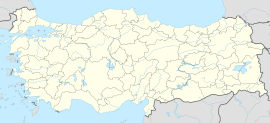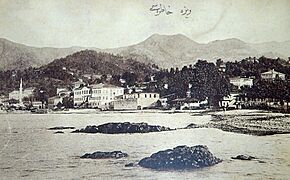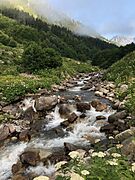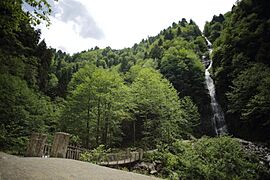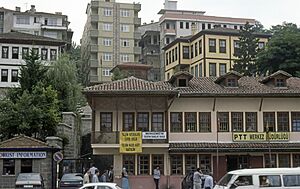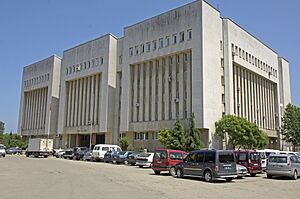Rize facts for kids
Quick facts for kids
Rize
|
|
|---|---|
|
Clockwise from top: View of Rize, Arch bridge across Firtina River, Rize Castle, Kaçkar Mountains National Park, Kiz Kulesi, Laz monument in Rize, Pokut Yaylası.
|
|
| Country | Turkey |
| Province | Rize |
| District | Rize |
| Population
(2021)
|
119,828 |
| Time zone | TRT (UTC+3) |
| Postal code |
53000
|
| Climate | Cfa |
Rize (Turkish pronunciation: [ɾi'ze]) is a city located right by the sea in the eastern part of Turkey's Black Sea Region. It is the main city of Rize Province and Rize District. About 119,828 people lived there in 2021. Rize is a typical city for its area, known for its calm atmosphere.
Since the border with Georgia opened in the early 1990s, the city has become richer. The road along the Black Sea coast was also made wider. The current Turkish President, Recep Tayyip Erdoğan, has family roots in Rize. The local university, Recep Tayyip Erdoğan University, is even named after him. The city is connected by road to Trabzon (66 km west), Hopa (88 km east, near the Georgian border), and Erzurum (south). A new airport, Rize–Artvin Airport, started operating in 2022.
Contents
What's in a Name?
The name Rize comes from the Greek word riza or Rizaion. This word means "mountain slopes" in Greek. In modern times, its Greek name was often Rizunda.
In Latin, the city was called Rhizus or Rhizaeum. The Catholic Church still uses Rhizaeum for the name of the town's old bishopric (a bishop's area of control). This area was once part of the ancient Roman province of Pontus Polemoniacus.
Other names for Rize used between the 17th and 19th centuries included Rizeh, Riseh, Rhizium, Irizeh, and Irissa. These names were often used by traders and merchants.
A Look Back: Rize's History
Arrian was the first writer to mention Rize. In his book, Periplus of the Euxine Sea, he described it as a city built at the mouth of a river with the same name. This river was called the Rizios Potamos in ancient Greek and Byzantine times.
Arrian's book was written around 130–131 AD as a letter to the Roman Emperor Hadrian. It tells how Arrian, who was the governor of Cappadocia, traveled around the eastern Black Sea area. This area was part of his job. He first visited the Roman Empire's army bases in eastern Anatolia before going to the Black Sea coast near Trabzon.
The city of Rize was once part of a historic Georgian area called Chaneti.
In 1547, the Chaneti province became part of the Ottoman Empire. It was then part of the Lazistan area. Between 1918 and 1920, the short-lived Democratic Republic of Georgia claimed the city. But based on the 1921 Treaty of Kars, Soviet Russia gave Rize to Turkey. This also included other areas like Artvin, Ardahan, and Hopa.
Rize's Location and Surroundings
Rize is built around a small bay on the Black Sea coast. It sits on a narrow strip of flat land between the sea and the tall mountains behind it. The land along the coast is being made bigger by adding more earth. The city is also growing up the steep hillsides away from the coast.
Rize is most famous for its black tea. Tea growing started in the region in the 1940s and 1950s. This changed the area, which used to be very poor. A local tea research center was started in 1958. You can see tea gardens all around the town, and some people even plant tea in their own gardens. Rize is a main place for processing and shipping the local tea.
More recently, kiwifruit plants have also been grown in Rize. Fishing is another important way people in the area earn money. Tourism to places in and around Rize is also becoming more popular.
Rize's Climate
Rize has a humid subtropical climate. This means it has warm summers, cool winters, and a lot of rain all year. The most rain falls in late autumn, from October to December.
The city does not get a lot of sunshine, even less than some places in Western Europe known for clouds. Snow sometimes falls, and when it does, it can be very heavy. The water temperature in the Black Sea near Rize is usually mild, staying between 8 and 20 degrees Celsius throughout the year.
| Climate data for Rize (1991–2020, extremes 1928–2020) | |||||||||||||
|---|---|---|---|---|---|---|---|---|---|---|---|---|---|
| Month | Jan | Feb | Mar | Apr | May | Jun | Jul | Aug | Sep | Oct | Nov | Dec | Year |
| Record high °C (°F) | 26.6 (79.9) |
28.1 (82.6) |
32.6 (90.7) |
35.8 (96.4) |
38.2 (100.8) |
36.1 (97.0) |
35.4 (95.7) |
35.6 (96.1) |
35.0 (95.0) |
33.8 (92.8) |
30.4 (86.7) |
26.7 (80.1) |
38.2 (100.8) |
| Mean daily maximum °C (°F) | 11.0 (51.8) |
11.1 (52.0) |
12.9 (55.2) |
15.9 (60.6) |
20.2 (68.4) |
24.9 (76.8) |
27.4 (81.3) |
28.1 (82.6) |
25.4 (77.7) |
21.4 (70.5) |
16.7 (62.1) |
13.0 (55.4) |
19.0 (66.2) |
| Daily mean °C (°F) | 6.9 (44.4) |
6.8 (44.2) |
8.7 (47.7) |
11.8 (53.2) |
16.6 (61.9) |
21.2 (70.2) |
23.8 (74.8) |
24.5 (76.1) |
21.2 (70.2) |
17.2 (63.0) |
12.1 (53.8) |
8.7 (47.7) |
15.0 (59.0) |
| Mean daily minimum °C (°F) | 3.9 (39.0) |
3.7 (38.7) |
5.4 (41.7) |
8.5 (47.3) |
13.2 (55.8) |
17.5 (63.5) |
20.5 (68.9) |
21.2 (70.2) |
17.7 (63.9) |
13.9 (57.0) |
8.8 (47.8) |
5.6 (42.1) |
11.7 (53.1) |
| Record low °C (°F) | −6.5 (20.3) |
−6.6 (20.1) |
−7 (19) |
−2.8 (27.0) |
4.0 (39.2) |
7.8 (46.0) |
12.0 (53.6) |
13.4 (56.1) |
4.6 (40.3) |
2.5 (36.5) |
−2.6 (27.3) |
−4 (25) |
−7.0 (19.4) |
| Average precipitation mm (inches) | 223.1 (8.78) |
170.5 (6.71) |
154.0 (6.06) |
90.5 (3.56) |
96.6 (3.80) |
148.4 (5.84) |
163.4 (6.43) |
192.5 (7.58) |
265.1 (10.44) |
307.3 (12.10) |
246.0 (9.69) |
252.1 (9.93) |
2,309.5 (90.93) |
| Average precipitation days | 15.53 | 14.43 | 16.83 | 15.63 | 15.73 | 15.97 | 14.37 | 15.10 | 15.27 | 15.73 | 13.60 | 15.27 | 183.5 |
| Average relative humidity (%) | 76.1 | 75.0 | 75.4 | 76.8 | 78.1 | 77.2 | 77.3 | 78.3 | 79.1 | 80.6 | 78.4 | 76.7 | 77.4 |
| Mean monthly sunshine hours | 62.0 | 84.8 | 114.7 | 144.0 | 179.8 | 195.0 | 176.7 | 161.2 | 156.0 | 127.1 | 87.0 | 58.9 | 1,547.2 |
| Mean daily sunshine hours | 2.0 | 3.0 | 3.7 | 4.8 | 5.8 | 6.5 | 5.7 | 5.2 | 5.2 | 4.1 | 2.9 | 1.9 | 4.2 |
| Source 1: Turkish State Meteorological Service | |||||||||||||
| Source 2: NOAA (humidity) | |||||||||||||
What Rize Produces
In the past, Rize grew oranges. However, bad weather in the early 20th century destroyed the crops. This caused the orange growing business to decline. The area also produced small amounts of manganese, a type of metal.
Rize's economy is mostly shaped by its mountains. It's hard to build big factories there because of the hilly land. Also, there are no trains, so most goods have to be moved by truck or ship. This makes it tricky to send goods out or bring them in.
Rize's main trading partner is Trabzon, which is the most developed city in the northeast Black Sea region. Rize mostly exports farm products. Tea and kiwifruit are its most popular goods. The state-owned tea company, Çaykur, is based in Rize.
Learning in Rize
Rize University was started in 2006. Its name was changed to Recep Tayyip Erdoğan University in 2011.
Culture and Landmarks
Rize Castle is an old castle that is partly in ruins. It is located southwest of the city center.
Sports in Rize
Rize has several places for sports. These include Rize Atatürk Stadium, Yeni Rize Şehir Stadı, and the Rize Sports Complex. The complex has the Rize Sports Hall and Rize Indoor Swimming Pool.
The city's main football team, Çaykur Rizespor, plays in the Süper Lig, which is Turkey's top football league. Another football team, Pazarspor, plays in the TFF Third League.
Rize's Mayors
Here are some of the people who have served as mayor of Rize:
- Ethem Şevki Kepenek (1950-1954)
- Ekrem Orhon (1965-1981)
- Şevki Yılmaz (1994-1995)
- Hızır Hop (1995-2004)
- Halil Bakirci (2004-2014)
- Reşat Kasap (2014-2019)
- Rahmi Metin (2019-present)
How Rize's Population Grew
| Year | Population |
|---|---|
| 1975 |
36,044
|
| 1980 |
43,407
|
| 1985 |
50,221
|
| 1990 |
52,031
|
| 1997 |
73,420
|
| 2000 |
78,144
|
| 2009 |
96,503
|
| 2021 |
119,828
|
See also
 In Spanish: Rize para niños
In Spanish: Rize para niños





